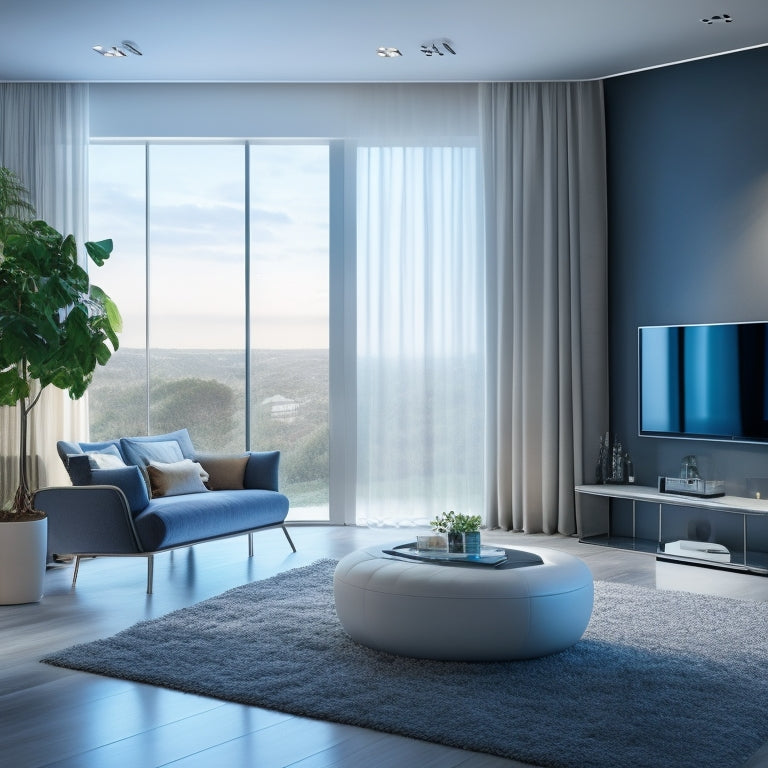
Mastering Home Automation: Your IoT Guide
Share
You're about to access a futuristic living space where devices work in harmony, and mastering home automation is the key. To get started, choose the right platform by considering affordability, ease of setup, and customization. Plan carefully to guarantee devices work seamlessly together, and explore networking options like mesh networks for reliability and range. Customize automation routines to suit your lifestyle, and secure your system with software updates and strong passwords. As you master the basics, you'll discover even more ways to optimize your smart home experience, and open up new possibilities for comfort, convenience, and control.
Key Takeaways
• Choose the right platform by considering affordability, ease of setup, and level of customization to suit your smart home needs.
• Ensure a seamless system by focusing on compatibility, integration, and conducting compatibility testing to identify issues early.
• Understand networking basics, including the benefits of mesh networks like Z-Wave and ZigBee, to ensure a stable and reliable connection.
• Customize automation routines to suit your lifestyle, integrating voice control, scenes, and automated triggers for a personalized experience.
• Prioritize security by implementing measures like software updates, strong passwords, and network segmentation to safeguard against IoT security breaches.
Choosing the Right Platform
When selecting a home automation platform, you'll need to weigh the trade-offs between affordability, ease of setup, and level of customization offered by consumer-level platforms like SmartThings or Wink, versus the polished, but expensive, closed systems of professional-level platforms like Control4 or Crestron.
Consumer-level platforms offer a range of customization options, allowing you to tailor your smart home to your specific needs. They also boast impressive integration capabilities, seamlessly connecting devices from various brands. However, be prepared to invest time and effort into setup and troubleshooting.
On the other hand, professional-level platforms provide a more streamlined experience, but at a hefty price tag. Consider your budget, technical expertise, and desired level of control when making your decision.
Building a Seamless System
As you begin constructing a seamless home automation system, compatibility and integration become essential considerations, necessitating careful planning to guarantee that your diverse devices work harmoniously together.
You'll face integration challenges, but compatibility testing can help you identify potential issues early on.
To guarantee a smooth user experience, optimize your devices by selecting ones that complement each other. For instance, pairing smart bulbs with a compatible hub can create a seamless lighting control experience.
By prioritizing device optimization, you'll avoid frustrating glitches and enjoy a harmonious smart home ecosystem.
Understanding Networking Basics
To summarize, you'll need to understand how your devices communicate with each other, so let's explore the networking basics that make your home automation system tick.
Mesh networks, like Z-Wave and ZigBee, offer reliability and range, as each device acts as a repeater to strengthen the signal. This means fewer dead spots and a more robust connection.
WiFi, on the other hand, is great for high-bandwidth tasks like streaming, but it can be prone to interference and congestion.
When choosing between the two, consider the mesh network advantages, such as its ability to handle device density and provide a more stable connection.
Meanwhile, be aware of WiFi limitations, like its sensitivity to physical barriers and network saturation.
Exploring Automation Possibilities
With your networking basics in place, it's time to harness your creativity and explore the vast possibilities of home automation, where a single command can trigger a cascade of events that transform your living space. You're now ready to tap into your inner automator!
Here are some exciting possibilities to get you started:
-
Customizing routines to fit your lifestyle, like turning off all lights with a single command
-
Exploring voice control options, like integrating Amazon Alexa or Google Assistant
-
Creating scenes that adjust lighting, temperature, and entertainment systems with a single tap
-
Setting up automated triggers based on your location, time of day, or weather
-
Integrating your favorite devices, like smart thermostats or security cameras, to create a seamless experience
Securing Your Smart Home
Now that you've explored the creative possibilities of home automation, it's time to shift your focus to the critical task of securing your smart home, where a single vulnerability can compromise your entire system.
You've invested in smart devices, but are you aware of their vulnerabilities? Smart device vulnerabilities can be a gateway to IoT security breaches. Don't let your smart home become a hackable haven!
Implement IoT security measures like regular software updates, strong passwords, and network segmentation to minimize risks. Isolate sensitive devices from the internet, and monitor your system for suspicious activity.
By taking these proactive steps, you'll safeguard your smart home from potential threats and guarantee a seamless automation experience.
Frequently Asked Questions
Can I Automate My Existing Devices or Do I Need New Ones?
You're wondering if you can automate your existing devices or need new ones? Good news: many devices can be retrofitted with automation capabilities, but compatibility is key - check if your devices support Z-Wave or ZigBee protocols for seamless integration!
How Do I Troubleshoot Issues With My Home Automation System?
'Something's gone haywire, and your smart home's on the fritz! Don't panic, you're not alone. First, examine your system logs to identify the culprit, then try power cycling the offending device - it's like a digital reboot, and it just might save the day!'
Are Home Automation Systems Compatible With Voice Assistants?
You're wondering if your home automation system plays nice with voice assistants? Yes, most systems are compatible with smart speakers like Alexa or Google Home, allowing you to control devices with voice commands - just make sure your hub supports the integration!
Can I Control My Home Automation System When I'm Away From Home?
"You're the conductor of your smart home orchestra, and remote access is the baton that lets you direct the show from anywhere. With geofencing features, your system knows when you're away, so you can control it remotely, effortlessly."
Will Home Automation Increase My Home's Resale Value?
You're wondering if your smart home will boost resale value? Absolutely! A well-integrated system can increase buyer appeal, prompting a higher appraisal impact, as it's a major selling point for tech-savvy homebuyers.
Related Posts
-

Revolutionize Your Kitchen With Clever Organizers
I've streamlined my kitchen by incorporating clever organizers that have transformed the way I cook and live. By maxi...
-

Food Safety Inspections Uncover Startling Violations
Food safety inspections in local establishments have uncovered a disturbingly high number of critical violations, put...

